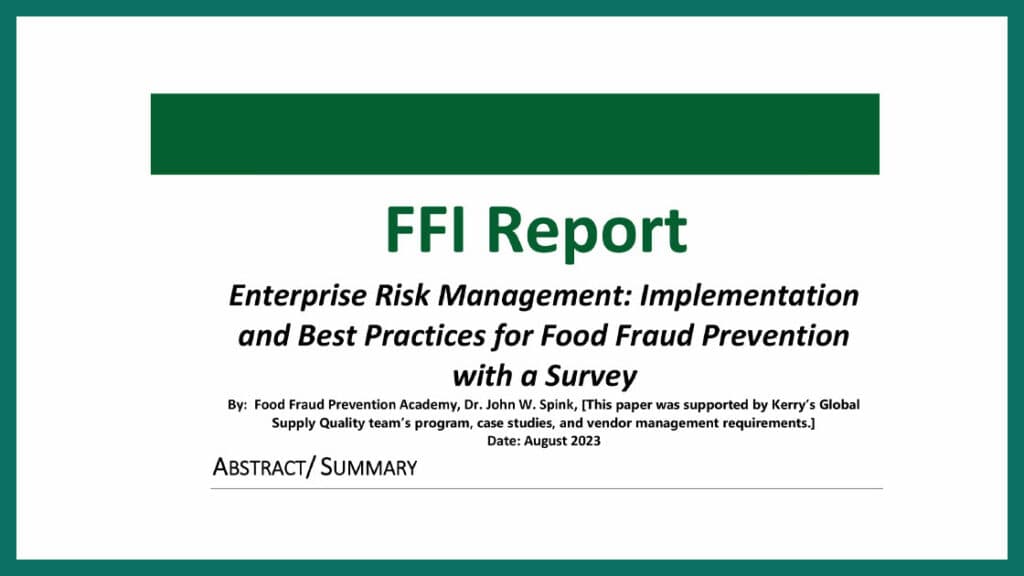This is a follow-up to our 2017 Food Fraud Insight Report (FFIR) on “Applying Enterprise Risk Management to Food Fraud Prevention.” This new report leveraged our most recent industry survey to gain insight. The evolved Kerry Global Supply Quality Risk and Vulnerability Management System demonstrates a best practice for food fraud prevention.
Our research group is pleased to announce a generous gift from Kerry’s Global Supply Quality team to support a Food Fraud Insight Report on “Enterprise Risk Management: Implementation and Best Practices for Food Fraud Prevention with a Survey.” Dr. Spink will present this report at the BRCGS Connect Food Safety Conference in Austin, Texas, on September 29, 2023.
Link to report: https://foodfraudpreventionthinktank.com/wp-content/uploads/2023/09/FFIR-Backgrounder-ERM-Implementation-w-Survey-Kerry-ERM3-v30.pdf
This is the third of three reports in our ERM series. The survey was conducted to focus on and understand the thoroughness of implementing Food Fraud Prevention Strategies. Food fraud prevention continues to evolve and formalize. The next step is more formal management systems, including more structured resource-allocation decision-making. Risk tolerance and risk appetite can become a standard and almost automatic process, which can decentralize split-second decision-making but still control the actions within an overall comfort level. A fully integrated system is possible and ideal for competently managing vulnerabilities and reducing the impact and cost of hazards. The case study example of the evolved Kerry Global Supply Quality Risk and Vulnerability Management System will help food fraud managers understand implementation.
Abstract/Executive Summary:
Background: This is the third report in a Food Fraud Insight Report (FFIR) series on COSO-based Enterprise Risk Management (ERM) for food fraud prevention. The first report presented an overview of the topic, and the second report expanded to insight into the decision-making and introduced a Food Fraud Management System. The Kerry Group’s Global Supply Quality Risk and Vulnerability Management System presented the example. As Food Fraud Prevention Strategies have matured, there is a need for this third report focusing on decision-making (e.g., risk appetite and risk tolerance). In addition, it is helpful to review a case study of the evolved Kerry system.
Methods: To supplement this work, an industry survey was conducted to gain insight into the awareness and implementation of this topic. These ERM-implementation questions were added to the Food Fraud Annual Update (FFAU) survey. The survey included a series of escalating detailed questions with answer responses of no, don’t know, prefer not to answer, or yes that had confidence levels of 100% sure, 75%, 50%, and 25%. This series captured the risk assessor’s confidence in their systems.
Results: Adopting an agile management philosophy is key to successfully reducing the fraud opportunity. The survey revealed that for food fraud prevention, there has been a focus on flexibility from the start. While the self-assessment was of high expertise – responders felt they had a high expertise – the implementation seemed incomplete or without a formal calibration to ERM/ COSO. Specifically, responses of the confidence of “Yes – 100% your systems are connected and calibrated” kept reducing.
Conclusion: The survey was conducted to focus on and understand the thoroughness of implementing Food Fraud Prevention Strategies. Food fraud prevention continues to evolve and formalize. The next step is more formal management systems, including more structured resource-allocation decision-making. Risk tolerance and risk appetite can become a standard and almost automatic process, which can decentralize split-second decision-making but still control the actions within an overall comfort level. A fully integrated system is possible and ideal for competently managing vulnerabilities and reducing the impact and cost of hazards. The case study example of the Kerry Global Supply Quality Risk and Vulnerability Management System will help food fraud managers understand implementation.
Risk Tolerance and Risk Appetite
The report provides a more detailed explanation of these two concepts that have become more important as food fraud prevention strategies are maturing. Of course, an illegal product is unacceptable (except for criminal organizations), but there are many more challenges when considering the idea of reducing and managing vulnerability. Fortunately, there are a lot of resources to provide insight. This report expands to add food fraud examples.
Survey Results – from the report
The food chain stakeholders and partners, anywhere in the supply chain, may have massive overconfidence in their level of food fraud prevention compliance, a basic understanding of the compliance requirements, a lack of calibration of their risk tolerance assessments (and thus, the identification of food fraud vulnerabilities that are a problem), the efficient connection between the FFVA and ERM risk tolerance, and an inefficiency or lag of crucial product recall information sharing.
Evolved Supply Quality Risk and Vulnerability Management Example – from the report
To help companies understand the full scope of food fraud prevention compliance requirements and the explanation of a centralized and integrated management system, a case study of an implemented model is included in the full report. To demonstrate the use case in detail – and not get too overwhelmed – a food fraud example is the focus of this section. Specifically, the Kerry Global Supply Quality Risk and Vulnerability Management System has evolved over the ten years this group has been operating. This section includes an overview of the Kerry Group and the Kerry Global Quality Supply Team, a summary of the basic management and governance model published in 2017, and a case study regarding the updated model.
Takeaway Points
- Food Fraud Prevention Strategies are maturing, including a more intense need for calibrating the risk tolerance levels.
- The Kerry Global Supply Quality Risk and Vulnerability Management System provides a use-case example, including their evolution from the 2017 report to the new 2023 update.
- While managing food fraud may not be easy, at least there are many resources to help you on the way, including this new report.
Acknowledgment:
This paper was supported by the Kerry Global Supply Quality Team. Link to Kerry Group: http://www.kerrygroup.com/

